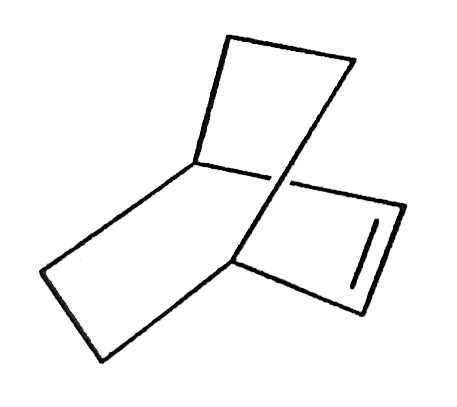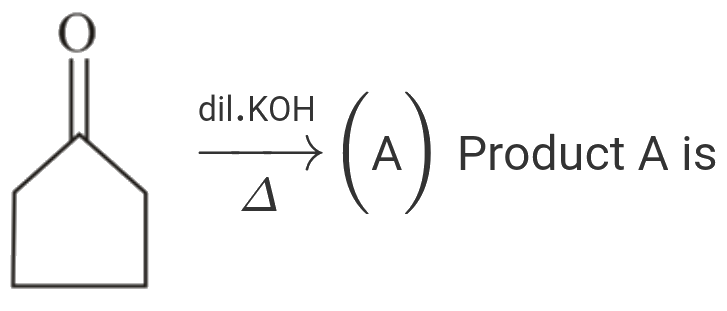gas evolved
Amino acid having
Two groups
One - COOH group
Two - COOH groups
Three - COOH groups
The correct Answer is:C
To solve the problem, we need to analyze the reaction of an amino acid with NaOH and CaO, and the subsequent reaction of the evolved gas with lime water. Here’s a step-by-step breakdown:
Step 1: Understand the Reaction
When 1 mole of an amino acid reacts with NaOH and CaO, a gas is evolved. The gas evolved in this reaction is carbon dioxide (CO2), which is produced during the decarboxylation of the amino acid.
Hint: Identify the type of reaction taking place when an amino acid is treated with a strong base like NaOH.
Step 2: Decarboxylation of Amino Acid
In the presence of NaOH, the carboxylic acid group (-COOH) of the amino acid undergoes decarboxylation, releasing CO2. The general reaction can be represented as:
RCH2COOH+NaOH→RCH2+CO2+H2O
Hint: Recall that decarboxylation leads to the loss of a carboxyl group as CO2.
Step 3: Determine the Amount of CO2 Evolved
The amount of CO2 evolved is directly related to the number of carboxylic acid groups present in the amino acid. If there are 'n' carboxylic groups, then 'n' moles of CO2 will be produced.
Hint: Consider how the number of carboxylic groups affects the amount of CO2 produced.
Step 4: Reaction with Lime Water
The CO2 gas evolved is then passed through lime water (Ca(OH)2). The reaction that occurs is:
CO2+Ca(OH)2→CaCO3+H2O
This results in the formation of calcium carbonate (CaCO3).
Hint: Understand the significance of lime water in detecting CO2.
Step 5: Calculate the Mass of Salt Formed
According to the problem, 0.1999 kg (or 199.9 g) of salt is formed. The molar mass of calcium carbonate (CaCO3) is approximately 100 g/mol.
To find the number of moles of CaCO3 formed:
Moles of CaCO3=199.9 g100 g/mol=1.999 moles≈2 moles
Hint: Use the molar mass to convert grams to moles.
Step 6: Relate Moles of CO2 to Carboxylic Groups
Since each mole of CO2 corresponds to one carboxylic acid group, the formation of 2 moles of CO2 indicates that the amino acid has 2 carboxylic acid groups.
Hint: Connect the amount of CO2 evolved to the number of carboxylic groups in the amino acid.
Conclusion
The amino acid in question has 2 carboxylic acid groups (COOH). Therefore, the correct answer is that the amino acid consists of 2 COOH groups.
Final Answer: The amino acid has 2 COOH groups.
When 1 mole of an amino acid reacts with NaOH and CaO, a gas is evolved. The gas evolved in this reaction is carbon dioxide (CO2), which is produced during the decarboxylation of the amino acid.
In the presence of NaOH, the carboxylic acid group (-COOH) of the amino acid undergoes decarboxylation, releasing CO2. The general reaction can be represented as:
RCH2COOH+NaOH→RCH2+CO2+H2O
The amount of CO2 evolved is directly related to the number of carboxylic acid groups present in the amino acid. If there are 'n' carboxylic groups, then 'n' moles of CO2 will be produced.
The CO2 gas evolved is then passed through lime water (Ca(OH)2). The reaction that occurs is:
CO2+Ca(OH)2→CaCO3+H2O
This results in the formation of calcium carbonate (CaCO3).
According to the problem, 0.1999 kg (or 199.9 g) of salt is formed. The molar mass of calcium carbonate (CaCO3) is approximately 100 g/mol.
Moles of CaCO3=199.9 g100 g/mol=1.999 moles≈2 moles
Since each mole of CO2 corresponds to one carboxylic acid group, the formation of 2 moles of CO2 indicates that the amino acid has 2 carboxylic acid groups.
The amino acid in question has 2 carboxylic acid groups (COOH). Therefore, the correct answer is that the amino acid consists of 2 COOH groups.
Topper's Solved these Questions
- BIOMOLECULESBOOK - AAKASH INSTITUTE ENGLISHCHAPTER - BIOMOLECULESEXERCISE - EXERCISE (ASSIGNMENT) SECTION - C Previous Years Questions
25 Videos
- BIOMOLECULESBOOK - AAKASH INSTITUTE ENGLISHCHAPTER - BIOMOLECULESEXERCISE - EXERCISE (ASSIGNMENT) SECTION - C Previous Years Questions (Questions asked Prior to Medical Ent. Exams. 2005
33 Videos
- BIOMOLECULESBOOK - AAKASH INSTITUTE ENGLISHCHAPTER - BIOMOLECULESEXERCISE - EXERCISE (ASSIGNMENT) SECTION - A Objective Type Questions
50 Videos
- AMINES BOOK - AAKASH INSTITUTE ENGLISHCHAPTER - AMINES EXERCISE - Assignment Section -J (Aakash Challengers Questions)
9 Videos
- CHEMICAL BONDING AND MOLECULAR STRUCTURE BOOK - AAKASH INSTITUTE ENGLISHCHAPTER - CHEMICAL BONDING AND MOLECULAR STRUCTURE EXERCISE - Assignment Section J (Aakash Challengers Questions)
10 Videos
Similar Questions
Knowledge Check
(A)SymmetricalKetoneLiAlH4−−−→(B)H⊕−−→ΔDiastereomers
Reactent (A) is :ACH3−O∣∣C−CH3BCH3−O∣∣C−CH2−CH3CCH3−CH2−O∣∣C−CH2−CH3DCH3−CH2−CH2−CH=OCHO| CHONaOH−−−→X
The product (X) will beA CH2ONa| COONaB COOH| COOHC CH2OH| COONaD CH2OH| CH2OHSuccinic acid Δ−−→(A)NH2−−→Δ(B)Br2−−→KOH(C),Product (C) will be :
ACH2−CO2H∣CH2−CH2−NH2BCH2−CO2H∣CH2−NH2CCH2−CO−2K+∣CH2−NH2DCH2−CO2H∣CH2−CH2−Br
(i) A(A morphous solid)O2−−−−−→airBlime water−−−−−→milky
(ii) Metal sulphide roasting−−−−→BgasKMnO4/H+−−−−−−−−→decolorisation ofKMnO4
(iii) B(gas)Fe3+−−→Fe2+
Correct statement is
View Solution (i)O3−−−−−−−−→(ii)Zn−H2O¯:OH−−→Δ NO. of aldol condensation product.
(i)O3−−−−−−−−→(ii)Zn−H2O¯:OH−−→Δ NO. of aldol condensation product.
View SolutionCH3−CH3∣CH∣CH3KmnO4−−−−→(A)H+−−→Δ(B)HBr−−−→ROOR(C)
Product (C) in the above reactions is :
View SolutionIn the following reaction sequence Y is,
PhOCOCH3AlCl3−−→Δ(X)I2−−−→NaOH(Y)
View Solution(A)(Hydrated salt)Storngly−−−−→heatedB+Ctransparentglassy bead
H3BO3Strongly−−−−→heatedC+D
Identify C-
View Solution

